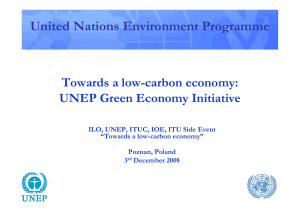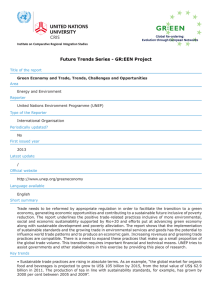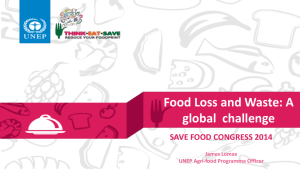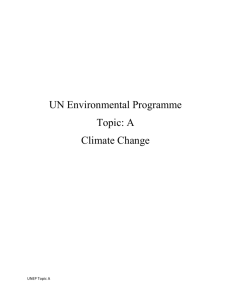Project Document Preparation
advertisement
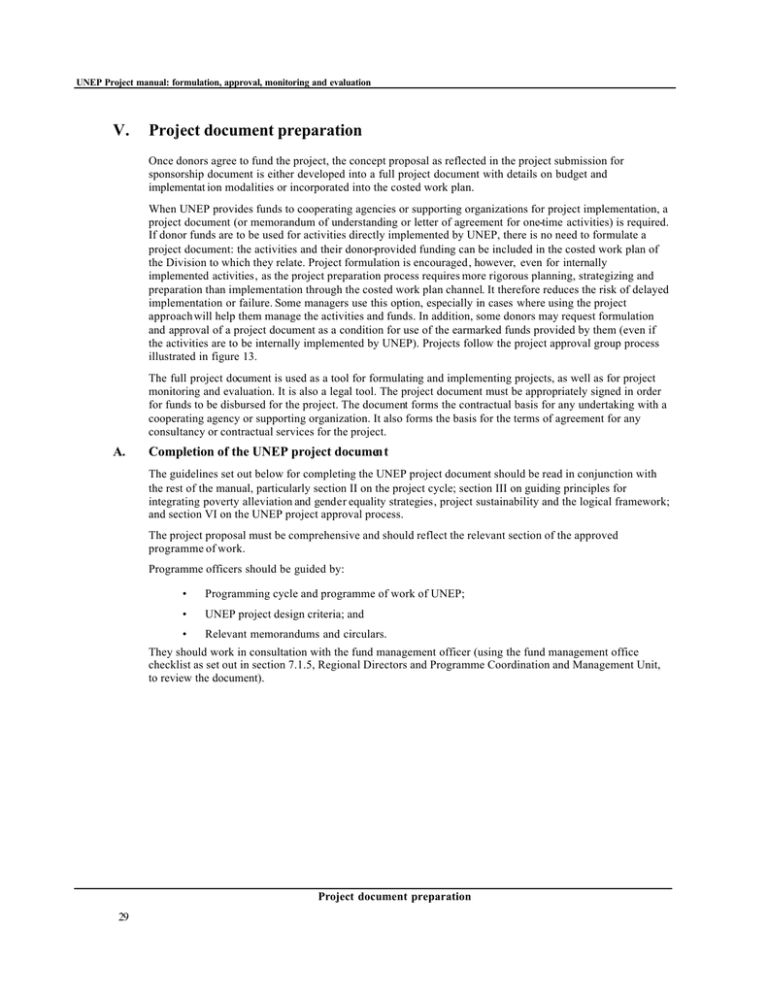
UNEP Project manual: formulation, approval, monitoring and evaluation V. Project document preparation Once donors agree to fund the project, the concept proposal as reflected in the project submission for sponsorship document is either developed into a full project document with details on budget and implementat ion modalities or incorporated into the costed work plan. When UNEP provides funds to cooperating agencies or supporting organizations for project implementation, a project document (or memorandum of understanding or letter of agreement for one-time activities) is required. If donor funds are to be used for activities directly implemented by UNEP, there is no need to formulate a project document: the activities and their donor-provided funding can be included in the costed work plan of the Division to which they relate. Project formulation is encouraged, however, even for internally implemented activities, as the project preparation process requires more rigorous planning, strategizing and preparation than implementation through the costed work plan channel. It therefore reduces the risk of delayed implementation or failure. Some managers use this option, especially in cases where using the project approach will help them manage the activities and funds. In addition, some donors may request formulation and approval of a project document as a condition for use of the earmarked funds provided by them (even if the activities are to be internally implemented by UNEP). Projects follow the project approval group process illustrated in figure 13. The full project document is used as a tool for formulating and implementing projects, as well as for project monitoring and evaluation. It is also a legal tool. The project document must be appropriately signed in order for funds to be disbursed for the project. The document forms the contractual basis for any undertaking with a cooperating agency or supporting organization. It also forms the basis for the terms of agreement for any consultancy or contractual services for the project. A. Completion of the UNEP project document The guidelines set out below for completing the UNEP project document should be read in conjunction with the rest of the manual, particularly section II on the project cycle; section III on guiding principles for integrating poverty alleviation and gender equality strategies, project sustainability and the logical framework; and section VI on the UNEP project approval process. The project proposal must be comprehensive and should reflect the relevant section of the approved programme of work. Programme officers should be guided by: • Programming cycle and programme of work of UNEP; • UNEP project design criteria; and • Relevant memorandums and circulars. They should work in consultation with the fund management officer (using the fund management office checklist as set out in section 7.1.5, Regional Directors and Programme Coordination and Management Unit, to review the document). Project document preparation 29 UNEP Project manual: formulation, approval, monitoring and evaluation B. Project document format UNITED NATIONS ENVIRONMENT PROGRAMME PROJECT DOCUMENT Section 1: Project identification 1.1 Title of subprogramme: 1.2 Title of project: (refers to proposed project) 1.3 Project number*: (to be allocated by BFMS) 1.4 Geographical scope: (refers to the countries or regions where the project will be implemented. 1.5 Implementation (internal, or cooperating agency or supporting organization) 1.6 Duration of the project : (total number of months) Commencing: Month, Year Completion: Month, Year 1.7 Cost of project: (Expressed in US $) US$ % Cost to the Environment Fund Cost to Trust Fund Cost to Earmarked Contribution Cost to the Cooperating Agency/Supporting Organization Programme Support Cost ( ___%) In-kind Contribution (including UNEP contribution) Total cost of the project ------------------------------ Signatures: For the Cooperating Agency/ Supporting Organization For UNEP Name and Functional Title Name and Functional Title ________________________________ _______________________________ * They are additional components compared to the UNEP concept proposal format. Project document preparation 30 * UNEP Project manual: formulation, approval, monitoring and evaluation (Continued) 1.8 Project summary Section 2: Project background 2.1 Background 2.2 Legislative authority and contribution to subprogrammes* Section 3: Proposal 3.1 Project description 3.2 Project impacts on poverty alleviation and gender equality * Section 4: Logical framework matrix (see figure 10 for UNEP logical framework matrix)* Section 5: Work plan* Section 6: Institutional framework * Section 7: Monitoring and reporting* 7.1 Activity reports Refer to section VII for details. (See annex X for format of the activity report). 7.2 Progress reports Refer to section VII for details. (See annex XI for format of the progress report). 7.3 Final report Refer to section VII for details (see annex XII for format of the final report). 7.4 Financial reports See annex V for standard text. 7.5 Terms and conditions See annex V for standard text. 7.4.1 Non-expendable equipment: 7.4.2 Responsibility for cost overruns: 7.4.3 Cash advance requirements: (See annex XV for format of the cash advance statement) Project document preparation 31 UNEP Project manual: formulation, approval, monitoring and evaluation 7.5 Publications Use standard paragraphs (see annex V). Section 8: Evaluation* Section 9: Project budget* ( See annex VI for the UNEP budget format) C. Key elements of the UNEP project document (a) Project summary A project summary must accompany all project proposals to be forwarded for approval. The project summary should include information on the main problems to be addressed, objectives of the project, the target groups, the main activities and geographical areas where the proposed project is to be implemented. (b) Background The project background must identify an d elaborate the problems the project intends to resolve. It must introduce readers and users of the document to the original logic of the project. This section should be concise, including only directly relevant material. The background sets the stage for understanding the subsequent segments of information presented in the project document. The background should include the following essential information: (c) • Specific problems or challenges faced by the targeted area or population; • Priority and urgency of the core problem; • Previous actions to address the problem and how the project complements these efforts; • Achievements and lessons learned from similar past projects; • Specific knowledge, experiences or competency that UNEP possesses in order to deliver the project successfully; • Relevant institutional capacity of UNEP and other implementing agencies. • Relevant activities of the recipient Government donors and other United Nations agencies, as appropriate, in order to show how the project might tie in with those activities. Legislative authority and contribution to subprogramme The project document should provide clear linkages to the Governing Council decisions for the biennium, the contribution to subprogrammes and the decisions and resolutions from the relevant United Nations conferences (Millennium Summit, World Summit on Sustainable Development, and so on). Governing Council decisions or General Assembly resolutions should be quoted where directly relevant (quote numbers and heading or title of relevant decisions or resolutions or insert a short sentence summarizing the content). (d) Project description The overall outline of the project should be described here. It should include information on: • How activities and output generation will b e carried out (methodology); • Implementation modalities with internal and external partners and stakeholders; • Criteria or justification for the project countries or regions selected, • How the proposed outputs and activities will help to address the current problem; Project document preparation 32 UNEP Project manual: formulation, approval, monitoring and evaluation (e) • Target beneficiaries and expected impacts on the target beneficiaries; • How the needs of particularly vulnerable or marginalized groups, such as women or people in poverty, will be addressed; • How the project managers would ensure successful implementation (strategies); • How the project will address the sustainability of capacities of the target beneficiaries; • If and how the project will ensure replicability of the project methodology, tool kits or lessons learned in other regions, countries or communities. Project impacts on poverty alleviation and gender-equality The project document needs to specify how the project contributes to achieving the Millennium Development Goal 1 (poverty reduction) and Goal 7 (environmental sustainability) which are further addressed in chapter II of the Plan of Implementation of the World Summit on Sustainable Development and its specific actions towards poverty eradication, and paragraph 7 of the Malmö Ministerial Declaration, which recognizes that the integration of environmental considerations in decision-making is necessary to confront the underlying causes of poverty. In April 2004, the UNEP senior management group decided that all UNEP activities must have a bearing on poverty eradication. Section III and annex III discuss the linkage between poverty and environment and some project intervention strategies for poverty alleviation. Gender issues have been part of the UNEP mandate since the 1980s. As part of its objective to help achieve sustainable development, UNEP is now urging that national and international policies and programmes at large must reflect gender equality and empowerment. This is in line with the Millennium Development Goals. In particular, Goal 3 calls for gender equality in proj ect planning and gender -inclusive approaches in the process of project planning. As women often bear a disproportionate burden of the world’s poverty, poverty and gender issues are closely interlinked. A strategic approach to addressing gender equality should be reflected in the project document considering the needs, capacities, benefits and burdens of women and men. (f) Logical framework Section 3 discusses the UNEP logical framework matrix in detail. The matrix format is shown in figure 10 and example is provided in annex IV. (g) Work plan The work plan sets out the timetable for carrying out project activities. The timetable must include the expected starting and completion dates (in month and year) for each activity. It must also state who is responsible for the implementation of each activity (cooperating agency, supporting organization or UNEP division). This information is best presented as a table. The work plan is an important tool for formulating and implementing a project. From the work plan, it is possible to assess the implementability of a project, as follows: • Are the time horizons realistic (for approval, negotiation with cooperating agencies or supporting organizations, delivery of outputs and administration)? • Is the work load reasonably balanced? • Are any activities likely to be held up by the timing of other activities? A well-prepared work plan is particularly useful for monitoring and evaluation. The work plan is used in the progress report as the reference point for assessing the project’s progress. As well as being an indicator of progress, the work plan also highlights difficulties likely to be encountered in project implementation, identifies backlogs or bottlenecks, and facilitates advance planning to resolve the anticipated problems. Project document preparation 33 UNEP Project manual: formulation, approval, monitoring and evaluation Figure 10: The UNEP logical framework matrix Objectives (State the overall broader objective, to which the project will contribute.) Intervention logic Results State the specific objectives, which the project shall achieve. 1. Objectively verifiable indicators (OVI) State quantitative or qualitative indicators showing whether and to what extent the project’s specific objectives are achieved.) 1.1. 1.2. Means of verification (MOV) Assumptions State the sources of information that exist or can be collected. State external factors and conditions not under the direct control of the project which are necessary to achieve these objectives. State risks to be considered. 1.1. 1.2. Outputs State the concrete outputs envisaged to achieve the results. What improvements and changes will be produced by the project? 1. 2. 3. Activities State the key activities to be carried out and their sequence in order to produce the outputs. 1.1. 1.2. 2.1. 2.2. 3.1. 3.2 3.3 (h) Institutional framework This subsection should give details of the management structure for project implementation. The roles and responsibilities of the cooperating agency or supporting organization should be clearly defined. The following issues must be addressed in formulating the institutional framework: • Who – organization, agency or individual – has ultimate authority for managing the project? • Who is or who are responsible for implementing specific activities of the work plan? • What are the respective roles and responsibilities of UNEP and the implementing organizations? • What is the machinery for implementation within UNEP, the implementing organization and national staff? • Who will report the project results and to whom? Project document preparation 34 UNEP Project manual: formulation, approval, monitoring and evaluation Figure 11: Work plan example 13 Activity Oct-Dec 2004 Jan-Jun 2005 Jun-Dec 2005 Jan-Jun 2006 Jun-Dec 2006 Lead institution Regional activities: Activity 1.1. Conduct statistical analysis of long-term normalized difference vegetation index data from the advanced ver y high resolution radiometer and ancillary data. ICRAF Activity 1.2. Sample these risk domains areas with moderate and high resolution satellite imagery and classify images into vegetation cover classes. ICRAF Activity 1.3. Identify candidatesites for ground sampling of sites. ICRAF Activity 2.1. Develop training manual on land degradation surveillance including satellite image acquisition and processing, soil spectral library development, and data analysis tools. ICRAF Activity 3.1. Hold regional training course for national scientists and resource managers on land degradation surveillance. ICRAF Activity 4.1. Conduct national scale environmental accounting (emergy evaluation) on status of national environmental resources, and evaluate land degradation impacts on economic/environmental systems. UNEP; UF/CEP Activity 4.2. Conduct a regional contrast with national scale emergy evaluation for seven other nations in the region less reliant on dryland resources. UNEP; UF/CEP Activity 4.3. Conduct historic time series emergy analysis at five-year intervals. UNEP; UF/CEP A work plan format is illustrated in figure 11, which lays out the relationship between activities, identification of responsible agencies or orga nizations and the timeframe for implementation. • What are the addresses for correspondence regarding the project (including e-mail addresses, if available)? • What are the mechanisms for monitoring and evaluation? 13 From the project entitled “An ecosystem approach to restoring West African drylands and improving rural livelihoods through agroforestry-based land management interventions”. Project document preparation 35 UNEP Project manual: formulation, approval, monitoring and evaluation Figure 12 is an example of a project management structure illustrated in a diagram format. This diagram is a useful tool when there are multiple subprojects and when more than one partner is involved in project implementation. (i) Monitoring and reporting The project document must specify the procedures to be used for monitoring and reporting. Both the routine monitoring and special monitoring requirements should be specified in the project document. Each project must have a monitoring plan indicating the frequency and schedule of reporting as well as the responsible reporters. UNEP project managers are responsible for ensuring that cooperating agencies or supporting organizations respect all UNEP project requirements regarding reporting, terms and conditions and new publications. These requirements should be accepted by the cooperating agencies or supporting organizations before the project document is approved by the project approval group. Standard paragraphs on these requirements are available in annex V and the relevant texts should be included in the project document as appropriate. (j) Evaluation This section should state what type of evaluation will be carried out (desk evaluation, independent in-depth evaluation, mid-term, terminal, or ex-post). It should also list the organizations that w ill participate in the evaluation. Evaluation and Oversight Unit should be consulted for any in-depth evaluation regarding terms of reference of the evaluation consultants, evaluation procedures and reporting. In-depth evaluation components should be included in the project if the total project budget is more than $500,000. Refer to section VIII for further details and criteria. Project document preparation 36 UNEP Project manual: formulation, approval, monitoring and evaluation Figure 12: Example of diagram on work responsibilities and coordination with stakeholders 14 International steering committee To provide overall policy guidance and vision on poverty– environment links. International networks of experts Provide technical briefs to technical advisory group. Produce technical papers for national institutions and commissions. Technical advisory group Provide technical advice and expertise to the international steering committee. Project coordinator Overall management and reporting. Provide substantive inputs. Regional institutions/Regional banks Ensure policy coherence between regional priorities and national o bjectives. Ensure that regional action plans are carried out. Ministries of Environment/Ministries of Finance and Planning Focal points for the implementation of activities at national level. Responsible for setting up national commissions. National institutions International research institutes Carry out planned activities. Provide technical backing to national institutes. Build needed capacities of national experts. Provide technical expertise. 14 From the project entitled “Strengthen environmental policy and management capacity on poverty alleviation and sustainable development in Africa” Project document preparation 37 UNEP Project manual: formulation, approval, monitoring and evaluation 11. Project budget Every project document must include a detailed project budget. The following are the main budget lines to be included in the project document. See annex VI for the UNEP budget format.15 10 Project personnel 1100 Project personnel Each post should be identified by a post number and recorded on a separate budget subline. Full job descriptions should be attached. (The title of the post and grade should be indicated). Budgetary provision should be expressed in United States dollar equivalent and in work months for each year of the budget; the minimum unit for posts is a half-month. Actual salary costs should be used where known, with the addition of an estimate for travel on recruitment, separation, home leave, and education grant – common staff costs. Where these are not known, standard costs by grade should be used, as amended from time to time. Standard salary costs include provision for travel on recruitment, home leave and repatriation, as well as education and separation grants. Travel on official business should not be budgeted under 1100. Staff training costs can be budgeted under 1100. Note: T he approval of the Executive Director is required for all new post s. 1200 Consultants Consultants' services (covered by special-service agreements) should be budgeted on a sep arate budget subline (one consultant per line). Firms should be offered institutional contracts. Terms of reference for each consultant should be attached. Standard costs, as revised from time to time, should be used to calculate costs. These include provision for fees, travel and per-diem. Where actual costs are known, these should be used instead of standard costs. For projects executed by a cooperating agency or a supporting organization, this subdivision excludes consultants hired directly by UNEP; they should be budgeted under line 1281. Only individuals can be offered special- service agreements, firms are offered contracts (see sub-component 20). 15 Office of Internal Oversight Services, United Nations audit report in 2002 suggested that UNEP ensure accurate, complete and verifiable financial information on publishing activities in the budget tables of the project documents. The budget table in the UNEP project manual can accommodate disaggregated budgetary information regarding publications, such as writing and editing, translation, printing and distribution, and so on. Project managers should make sure, as much as possible, that reporting or publication budget information is provided in a disaggregated format. Project document preparation 38 UNEP Project manual: formulation, approval, monitoring and evaluation 1300 Administrative support personnel Administrative support personnel include: a) Administrative assistants (as distinct from professional administrative officers), secretaries, typists, clerks, drivers, and so on. b) Translators, revisers, interpreters and conference typists (recruited for meetings). Full job descriptions for each of the above should be attached. (The title of the post and grade should be indicated). Items such as temporary assistance and overtime should also be budgeted under this subdivision. The above rules for budgeting for 1100 also apply. Note: For internally implemented projects and costed work plans approval of the Executive Director is required before a new post is included. 1400 Volunteers A proforma per-month cost should be used for volunteers when it is not possible to estimate actual costs. Work-months should be indicated. 1600 Travel on official business All mission costs (travel costs and per-diem) relating to the travels of project personnel on official business (other than travel for recruitment, home leave and repatriation which are budgeted under 1100 and 1300) must be included under this budget subline. For internally implemented projects, other than those implemented by a UNEP regional office or units outside Nairobi, which are budgeted under 1681, travel undertaken by UNEP personnel, including travel to meetings, should also be budgeted under 1600. Note: Travel of UNEP staff under 1600 should be project activity oriented and reflected in the project work plan. 20 Subcontracts 16 Contracts (including memorandums of understanding and letters of agreement – see annex XIX for guidelines) other than those listed below should be budgeted at their estimated costs and shown separately. The nature of the contract should be specified in the work sheet. The following contracts should not be included under this budget subline: 2100 (a) Personnel contracts – lines 1100; (b) Consultancy contracts – lines 1200; (c) Repair and maintenance of equipment – lines 5100; (d) (e) Equipment purchases – lines 4100 or 4200; Printing and publishing contracts - Lines 5200. Subcontracts with cooperating agencies (United Nations) or 2200 Subcontracts with supporting organizations (non United Nations and non-profit-making) 30 Training 16 Projects involving acquisition of property, including products and real property, an d of services have to undergo the procurement process. The requirements for and the methods of effecting procurement depend on its estimated cost and other consideration. Project document preparation 39 UNEP Project manual: formulation, approval, monitoring and evaluation 3100 Fellowships Budgetary provision should be made for the total estimated costs of all fellowships, including travel, stipend and training fees. 3200 3101 Stipend 3102 Travel costs Group training This item should be used for budgeting participation in training courses, seminars, workshops, study tours, and so on. The cost of travel and per- diem should be separately estimated for each training course or workshop: 3201 Training course on ___________ 3202 Study tours (sometimes study tours and field trips are part of training courses or workshops); 3203 Workshops or seminars on __________ The approximate number of participants should be indicated together with tentative dates and venue. Note: UNEP, in principle, provides funds only for training of participants from developing countries. 3300 Meetings or conferences Budgetary provision should be made for the total estimated costs of participation in meetings, conferences, and so on. The approximate number of participants should be indicated together with tentative dates and venue. UNEP staff participation (travel and per- diem) in meetings and study tours should not be included under any of the above lines, but under lines 1600 as appropriate. 40 Equipment and premises 4100 Expendable equipment This refers to expendable property or equipment with an original cost of under $1,500, for which inventory records are not maintained. Purchase of office supplies, books and documents, disposable laboratory equipment, and so on should be budgeted under this line. 4200 Non-expendable equipment This includes items of property or equipment valued at $1,500 or more per unit, usually with a serviceable life of five years or more, as well as items of attraction such as pocket calculators. Property records and controls must be maintained and inventory forms submitted to UNEP with half-yearly progress reports submitted on 30 June. Note: • A list of non-expendable equipment, including the estimated costs, should be attached to the project document; • The definitions used here are those employed throughout the United Nations system (see ST/AI/374 dated 16 January 1992). 4300 Premises When it is necessary to purchase or rent premises to implement a project, the cost should be estimated and shown against this line. Maintenance of premises should also be budgeted under this line. 50 Miscellaneous 5100 Rental, operation and maintenance of equipment Budgeted under this line are: rental, operation and maintenance of office and computer equipment; repair, maintenance and insurance of vehicles; purchase of petrol, and rental of meeting room and equipment. 5200 Reporting cost Estimated or standard costs should be budgeted for editing, translation, printing, and distribution of reports and publications, and shown under separate budget sublines. Project document preparation 40 UNEP Project manual: formulation, approval, monitoring and evaluation 5300 Sundry This item covers expenditures such as freight and port clearance charges, postage and communications costs. 5400 Hospitality This item covers the hospitality expenses incurred in connection with receptions given in honour of participants in conferences, seminars, and so on., held under the project. Where hospitality or entertainment costs are involved, the reason for, the type of hospitality, and the numbers invited should be indicated precisely. Expenditures should be incurred in accordance with the official hospitality guidelines (see ST/AI/192/Rev.2 dated March 1993). 5500 Monitoring and Evaluation Budgetary provision should be made for the monitoring and evaluation of projects, in particular, for projects with a cumulative budget of $500,000 or more, as well as for pilot and demonstration projects. Criteria for determining budget subline against which travel should be charged 1100 Project personnel Travel for recruitment, separation, home leave and education grants of the staff members as well as their dependents, is covered by the common staff costs included in the amount budgeted for each post, and is authorized by the Human Resources Management Service (UNON) once they have received a request to recruit against one of the project posts. 1200 Consultants Travel of consultants recruited against line 1200 should always be charged to the same budget subline. 1300 Administrative support This covers the same travel as in line 1100, in regard to GS staff, translators, revisers, interpreters and temporary assistance personnel where appropriate. Conference servicing costs including translators, interpreters, and sound engineers (travel, DSA and salaries), should be budgeted under 1321, 1322 and so on. 1600 Travel on official business All mission travel of project personnel not covered by common staff costs under 1100 or 1300 above, is to be charged to this line. 3100 Fellowships Travel (as well as stipend, training fees, and so on) of fellows. 3200 Group training Travel (as well as stipend, training fees, and so on) of trainees. 3300 Meetings or conferences Travel of participants in the meet ings or conferences should be charged under this line. Travel of project personnel, agency staff or UNEP staff must not be charged to this budget line even when they are attending such meetings. Their travel should be charged to line 1300 or 1600 as appropriate. Agency staff travel should come from the contribution to the project budget by the agency concerned. Line 1220, 3220, 4120, 4220 and so on Unspecified The inclusion of unspecified as an object of expenditure line should be temporary for budgeting purposes only. Once the activities become clear, the actual object of expenditure lines should be identified and expenditures charged to those lines and reflected in future revisions. Project document preparation 41

